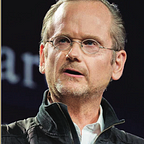We ran an experiment to see how “ranked-choice voting” would work on the current field of Democratic candidates for President. I’m not sure we’ve done it correctly, but I wanted to describe what we’ve done here, and make the data available to others.
RCV gives voters the chance to rank their preferences in an election. If the first ranked candidate doesn’t meet the threshold, then their second vote is counted. If that candidate doesn’t meet the threshold either, then their third is counted. And so forth. The objective is to avoid “wasted votes” — or better, “wasted voters” (not in that sense) — meaning a voter whose preferences disappear from the election, because their candidate does not come even close to winning.
Beyond simply ranking, our interest was also to see whether there was a clear “Keynesian beauty contest” (not in that sense) effect. JM Keynes had written about this a century ago: that people will vote for the person they think is going to win even if there’s another person they like better. Here’s Keynes in his own words:
It is not a case of choosing those [faces] that, to the best of one’s judgment, are really the prettiest, nor even those that average opinion genuinely thinks the prettiest. We have reached the third degree where we devote our intelligences to anticipating what average opinion expects the average opinion to be. And there are some, I believe, who practice the fourth, fifth and higher degrees. (Keynes, General Theory of Employment, Interest and Money, 1936).
One theory behind RCV is that it might give people license to vote for the person they like most at least at first, even if that person does not seem likely to win in the end.
So here was our method: We asked YouGov to run a survey of 1,000 voters, split into two groups (run May 25–28). One group was asked to simply indicate their choice for the Democratic nomination. (Specifically: “If the election were held today, and you could choose only one, which candidate would you vote for?”) The results of that were as in Table 1:
The second group was asked to rank their choices for President. (Specifically: “Please rank your top 5 preferred candidates, in order, for the Democratic Presidential primary or caucus in your state in 2020.”) I worry we should have explained the idea of ranking more, making it clear that if their first choice vote didn’t prevail, then their second choice would be counted, etc. But alas, we didn’t.
We then took the rankings from that second group and ran it through the (really fantastic) engine at OPAVote.com. (Here’s the BLT file.)
We ran three scenarios — ranking down to the top 5, the top 2, and the top 1. The results are really interesting.
The ranking to the top 5 doesn’t look very different — basically, the same order as Table 1, except Mayor Pete is slightly higher than Senator Harris. (PDF, CSV, JSON).
The ranking to the top 2 looks very different — Biden gets 45.3%, and Warren gets 28%. (PDF, CSV, JSON).
The ranking to the top 1 looks confirms that ordering—Biden gets 58.3% and Warren 41.7%. (PDF, CSV, JSON).
This is extremely interesting, and it shows something of the dilemma the Democrats are now facing. The party is basically split, and the consensus challenger now seems increasingly clear.
Here’s the raw data from YouGov. If you notice any errors or have better ideas or different analyses, please post in the comments.
This work was sponsored by EqualCitizens.US. If you’d like to spread some gold for this free data, you can donate here. Or join our latest campaign to make sure that the critical reform advanced by Kirsten Gillibrand gets on the stage in the Democratic Primary.
